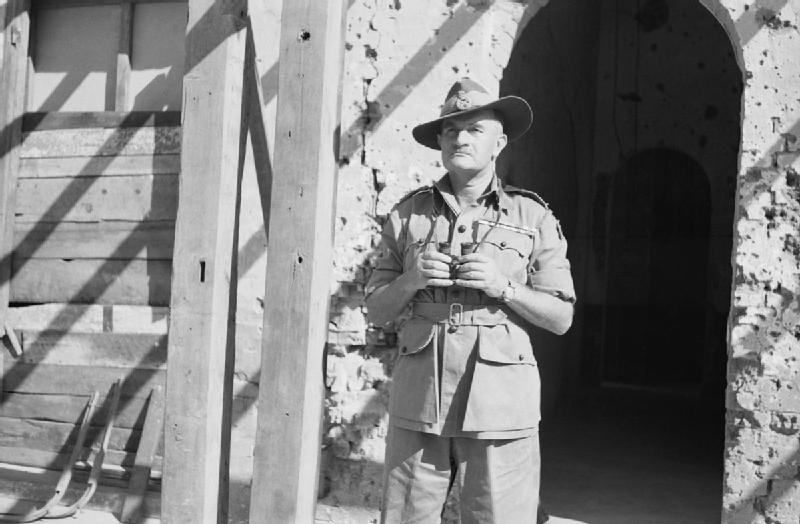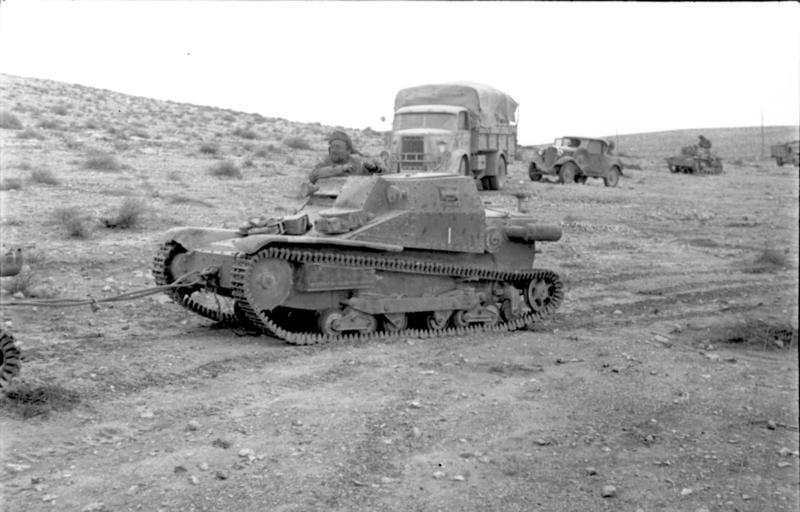|
Wilfrid Lewis Lloyd
Major General Wilfrid Lewis Lloyd CBE, DSO and Bar, MC (1 March 1896 – 22 January 1944) was an officer in the British Army and the British Indian Army during the First and Second world wars. Early life Lloyd was born in York, England, on 1 March 1896, son of Major Ernest Thomas Lloyd (1860-1935), formerly of the Bengal Civil Service, and his wife Ethel Mary (died 1961), second daughter of Sir Richard Dansey Green-Price, 2nd Baronet. Sir Guy Lloyd, 1st Baronet (1890-1987), another future British Army officer and Member of Parliament, was his elder brother. First World War Lloyd was commissioned into the 7th (Service) Battalion of the King's Shropshire Light Infantry in September 1914, arrived in France in October 1915, and fought with the regiment until 1917, winning a Military Cross during the Battle of the Somme. In 1917 he transferred to the Indian Army and was attached to 4th / 39th Garwhal Rifles. He was later to join the 19th Hyderabad Regiment. He remained in the arm ... [...More Info...] [...Related Items...] OR: [Wikipedia] [Google] [Baidu] |
Major-general (United Kingdom)
Major general (Maj Gen) is a "two-star" rank in the British Army and Royal Marines. The rank was also briefly used by the Royal Air Force for a year and a half, from its creation to August 1919. In the British Army, a major general is the customary rank for the appointment of division commander. In the Royal Marines, the rank of major general is held by the Commandant General. A Major General is senior to a Brigadier but subordinate to lieutenant general. The rank is OF-7 on the NATO rank scale, equivalent to a rear admiral in the Royal Navy or an air vice-marshal in the Royal Air Force and the air forces of many Commonwealth countries. The rank insignia is the star (or 'pip') of the Order of the Bath, over a crossed sword and baton. In terms of orthography, compound ranks were invariably hyphenated, prior to about 1980. Nowadays the rank is almost equally invariably non-hyphenated. When written as a title, especially before a person's name, both words of the rank ... [...More Info...] [...Related Items...] OR: [Wikipedia] [Google] [Baidu] |
4th Infantry Division (India)
The 4th Indian Infantry Division, also known as the Red Eagle Division, is an infantry division of the Indian Army. This division of the British Indian Army was formed in Egypt in 1939 during the Second World War. During the Second World War, it took part in campaigns in East Africa (Eritrea and Sudan), Syria, North Africa and Italy. Post independence, the division is part of the I Corps and headquartered at Prayagraj. History North Africa During the war, the 4th Indian Division was in the vanguard of nine campaigns in the Mediterranean theatre. Major-General The Hon. P. Gerald Scarlett appears to have been the division's first commander, from October 1939 to January 1940. The British 14th Infantry Brigade was attached to the division from 1 June to 20 July 1940; the British 16th Infantry Brigade was attached from 9 September 1940 to 14 December 1940. In the first of Archibald Wavell's operations in Egypt, as part of the Western Desert Force, it took part in Operati ... [...More Info...] [...Related Items...] OR: [Wikipedia] [Google] [Baidu] |
10th Indian Infantry Division
The 10th Indian Infantry Division was a war formed infantry division of the Indian Army during World War II. In four years, the division travelled over from Tehran to Trieste, fought three small wars, and fought two great campaigns: the Anglo-Iraqi War, the Invasion of Syria-Lebanon, the Anglo-Soviet invasion of Iran, the North African Campaign, and the Italian Campaign. After the partition of India, the division was allocated to the Pakistan Army. The Pakistani 10 Infantry Division is part of the IV Corps and is located in Lahore. The division was re-raised on 1 April 1965 as part of the independent Indian Army at Bangalore and Belgaum in Karnataka as 10 Mountain Division. World War II The Division was formed in January 1941 at Ahmednagar, out of the 20th, 21st and 25th Indian Infantry Brigades. The first General Officer Commanding was Major-General W.A.K. Fraser. The division landed in Basra in April, 1941 for the Anglo-Iraqi War. On 16 May 1941, Major General ... [...More Info...] [...Related Items...] OR: [Wikipedia] [Google] [Baidu] |
William Slim, 1st Viscount Slim
Field Marshal William Joseph Slim, 1st Viscount Slim, (6 August 1891 – 14 December 1970), usually known as Bill Slim, was a British military commander and the 13th Governor-General of Australia. Slim saw active service in both the First and Second World Wars and was wounded in action three times. During the Second World War he led the Fourteenth Army, the so-called "forgotten army" in the Burma campaign. After the war he became the first British officer who had served in the Indian Army to be appointed Chief of the Imperial General Staff. From 1953 to 1959 he was Governor-General of Australia. In the early 1930s, Slim also wrote novels, short stories, and other publications under the pen name Anthony Mills. Early years William Slim was born at 72 Belmont Road, St Andrews, Bristol, the son of John Slim by his marriage to Charlotte Tucker, and was baptised there at St Bonaventure's Roman Catholic church, Bishopston. He was brought up first in Bristol, attending St Bonave ... [...More Info...] [...Related Items...] OR: [Wikipedia] [Google] [Baidu] |
Arakan Campaign 1942–43
The Arakan Campaign of 1942–43 was the first tentative Allied attack into Burma, following the Japanese conquest of Burma earlier in 1942, during the Second World War. The British Army and British Indian Army were not ready for offensive actions in the difficult terrain they encountered, nor had the civil government, industry and transport infrastructure of Eastern India been organised to support the Army on the frontier with Burma. Japanese defenders occupying well-prepared positions repeatedly repulsed the British and Indian forces, who were then forced to retreat when the Japanese received reinforcements and counter-attacked. Prelude Situation in 1942 In May 1942, the Allies retreated from Burma, accompanied by many refugees, mainly Indian and Anglo-Burmese. Although the Japanese halted their advance on the Chindwin River (mainly because the heavy monsoon rains descended at this point and made the roads and tracks through the mountainous frontier between India and Burm ... [...More Info...] [...Related Items...] OR: [Wikipedia] [Google] [Baidu] |
14th Indian Infantry Division
The 14th Indian Infantry Division was an infantry division of the Indian Army during World War II. It fought in the Arakan Campaign 1942–43, and was subsequently converted into a Training Division, providing drafts of replacements for units of the Fourteenth Army during the Burma Campaign. History as 14th Indian Division Formation and early actions The division was raised on 1 June 1941, at Quetta in Baluchistan. Its badge was a depiction in black and white of the ranges of mountains above Quetta, surrounded by a stylised letter "Q" in white on a black background. The division had temporary commanders while forming. On 15 October 1941, Major General Wilfrid Lewis Lloyd, who had a distinguished record as commander of a brigade in the Western Desert, was appointed commander. When first formed, the division was intended to operate in Iraq and Persia, then under Allied military occupation, and first trained for mountain and desert warfare. It consisted of the 23rd, 36th a ... [...More Info...] [...Related Items...] OR: [Wikipedia] [Google] [Baidu] |
Damascus
)), is an adjective which means "spacious". , motto = , image_flag = Flag of Damascus.svg , image_seal = Emblem of Damascus.svg , seal_type = Seal , map_caption = , pushpin_map = Syria#Mediterranean east#Arab world#Asia , pushpin_label_position = right , pushpin_mapsize = , pushpin_map_caption = Location of Damascus within Syria , pushpin_relief = 1 , coordinates = , subdivision_type = Country , subdivision_name = , subdivision_type1 = Governorate , subdivision_name1 = Damascus Governorate, Capital City , government_footnotes = , government_type = , leader_title = Governor , leader_name = Mohammad Tariq Kreishati , parts_type = Municipalities , parts = 16 , established_title = , established_date ... [...More Info...] [...Related Items...] OR: [Wikipedia] [Google] [Baidu] |
Free French
Free France (french: France Libre) was a political entity that claimed to be the legitimate government of France following the dissolution of the Third Republic. Led by French general , Free France was established as a government-in-exile in London in June 1940 after the Fall of France during World War II and fought the Axis as an Allied nation with its Free French Forces (). Free France also supported the resistance in Nazi-occupied France, known as the French Forces of the Interior, and gained strategic footholds in several French colonies in Africa. Following the defeat of the Third Republic by Nazi Germany, Marshal Philippe Pétain led efforts to negotiate an armistice and established a German puppet state known as Vichy France. Opposed to the idea of an armistice, de Gaulle fled to Britain, and from there broadcast the Appeal of 18 June () exhorting the French people to resist the Nazis and join the Free French Forces. On 27 October 1940, the Empire Defens ... [...More Info...] [...Related Items...] OR: [Wikipedia] [Google] [Baidu] |
Battle Of Keren
The Battle of Keren ( it, Battaglia di Cheren) took place from 3 February to 27 March 1941. Keren was attacked by the British during the East African Campaign of the Second World War. A force of Italian regular and colonial troops defended the position against British troops (mostly from Sudan and British India) and Free French forces. The town of Keren, in the colony of Italian East Africa, was of tactical importance to both sides. The road and railway through Keren were the main routes to the colonial capital of Italian Eritrea at Asmara and the Red Sea port of Massawa, which surrendered to the British after the battle. Background Eritrea Colonised by the Italians in 1885, Italian Eritrea was used as a staging ground for Italian invasions of the Ethiopian Empire in the First and Second Italo-Abyssinian Wars. The second invasion began in 1935 and Ethiopia fell in 1936. Ethiopia, Italian Somaliland and Eritrea were combined to form Italian East Africa (''Africa Orie ... [...More Info...] [...Related Items...] OR: [Wikipedia] [Google] [Baidu] |
Battle Of Agordat (World War II)
{{disambig ...
Battle of Agordat may refer to: *First Battle of Agordat (1890) *Second Battle of Agordat (1893) *Battle of Agordat (1941) The Battle of Agordat was fought near Agordat in Eritrea from 26 to 31 January 1941, by the Kingdom of Italy, Italian army and Royal Corps of Colonial Troops against British, Commonwealth and Indian forces, during the East African Campaign (World ... [...More Info...] [...Related Items...] OR: [Wikipedia] [Google] [Baidu] |
Operation Compass
Operation Compass (also it, Battaglia della Marmarica) was the first large British military operation of the Western Desert Campaign (1940–1943) during the Second World War. British, Empire and Commonwealth forces attacked Italian forces of the 10th Army (Marshal Rodolfo Graziani) in western Egypt and Cyrenaica, the eastern province of Libya, from December 1940 to February 1941. The Western Desert Force (WDF) (Lieutenant-General Richard O'Connor) with about advanced from Mersa Matruh in Egypt on a five-day raid against the Italian positions of the 10th Army, which had about in fortified posts around Sidi Barrani in Egypt and in Cyrenaica. The WDF swiftly defeated the Italians in their fortified posts and at Sidi Barrani and then exploited the success, forcing the rest of the 10th Army out of Egypt and capturing the ports along the Libyan coast. The 10th Army was cut off as it retreated towards Tripolitania and defeated at the Battle of Beda Fomm, the remnants being pu ... [...More Info...] [...Related Items...] OR: [Wikipedia] [Google] [Baidu] |




